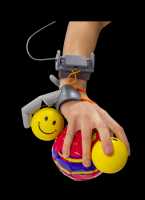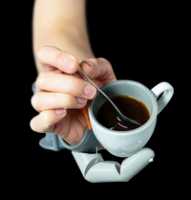
28 May Robotic Third Thumb Quickly Becomes Useful in Everyday Tasks
MedicalResearch.com Interview with:

Dani Clode
Dani Clode
Designer & Senior Research Technician
Plasticity Laboratory
Institute of Cognitive Neuroscience
University College London
MedicalResearch.com: What was the inspiration behind creating the Third Thumb?

Third Thumb Dani Clode Design
Response: From a design perspective, augmentation is about designing a new relationship with technology, creating something that is no longer just a tool for the hand, but instead an extension of the hand. I created the Third Thumb during my Design Product Masters project at the Royal College of Art (London). The Third Thumb is a flexible 3D-printed thumb extension for your hand, controlled by your toes. It is operated wirelessly with pressure sensors and affords proportional control over two degrees of freedom. The project began as a way to better understand what it was like to control something extra attached to my body. As an upper-limb prosthetics designer,
I wanted to understand the unique relationship between a person and a prosthetic, it’s a relationship unlike any other product, and I wanted to explore that. The Plasticity Lab then got in contact with me after seeing the Third Thumb online, as they were already exploring augmentation in the brain. We started collaborating on this research shortly after, and I now work as an in-house designer for the Plasticity Lab, collaborating on neuroscience research.
What is the Third Thumb? And how does it work?

Third Thumb Dani Clode Design
Response: The Third Thumb is a flexible 3D printed thumb extension for your hand, controlled by your feet. It is worn on the hand, next to your little finger and dynamically moves like a thumb by using two motors controlled by two pressure sensors retrofitted into your shoes, under your toes, and communicating with the Thumb wrist piece wirelessly. The foot control is inspired by products that help to develop the already strong connection between our hands and our feet. For example driving a car, using a sewing machine, or playing a piano.
MedicalResearch.com: What are the key findings from your research?
Response: We found that people can quickly learn to control an extra Thumb, and use it for their benefit in daily life scenarios. At the end of the training, some of our participants even reported that they started to feel like the Thumb was becoming a part of their body.

Third Thumb Dani Clode Design
MedicalResearch.com: Why should people care about this?
Response: This is the first augmentation study carried over multiple (five) days of prolonged training, and the first to have an untrained (unmoving Thumb) comparison group. The success of our study shows the value of neuroscientists working closely together with designers and engineers, to ensure that augmentation devices make the most of our brains’ ability to learn and adapt, while also ensuring that augmentation devices can be used safely

Third Thumb_Needle
MedicalResearch.com: What most surprised or interested you about your findings?
Response: We were also surprised to see people forming such strong bonds with the Thumb. Some of our participants needed a little bit of time to say goodbye to the Thumb; or reported feeling like they were missing something after the training had finished.
MedicalResearch.com: How might these lessons apply to other augmentative additions humans might have in the future?
Response: The success of our study shows the value of neuroscientists working closely together with designers and engineers. The upgrades made to the Third Thumb design during the research were very much influenced by the study, and equally the study was influenced by the design of the Thumb. It was a unique study, but this kind of collaborative research needs to happen more in the future to ensure that augmentation devices make the most of our brains’ ability to learn and adapt.
Citation:
Robotic hand augmentation drives changes in neural body representation
BY PAULINA KIELIBA, DANIELLE CLODE, RONI O. MAIMON-MOR, TAMAR R. MAKIN
SCIENCE ROBOTICS19 MAY 2021
JOIN OUR EMAIL LIST
[mailpoet_form id="5"]We respect your privacy and will never share your details.
[last-modified]
The information on MedicalResearch.com is provided for educational purposes only, and is in no way intended to diagnose, cure, or treat any medical or other condition. Always seek the advice of your physician or other qualified health and ask your doctor any questions you may have regarding a medical condition. In addition to all other limitations and disclaimers in this agreement, service provider and its third party providers disclaim any liability or loss in connection with the content provided on this website.
Last Updated on May 28, 2021 by Marie Benz MD FAAD
